Magic Origins brought us a new ability keyword — Spell Mastery. We shall analyze it while taking a look at Nissa’s Pilgrimage, and while we are at it, we shall talk a little about unofficial card comparison that professionals recur to when evaluating new cards.
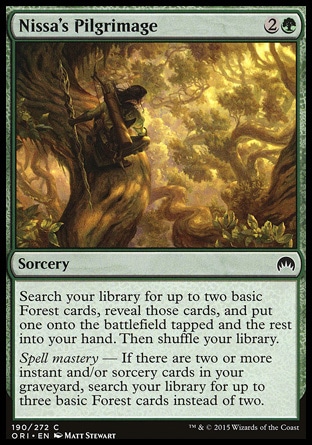
Oracle Text:
Sorcery
Search your library for up to two basic Forest cards, reveal those cards, and put one onto the battlefield tapped and the rest into your hand. Then shuffle your library.
Spell mastery — If there are two or more instant and/or sorcery cards in your graveyard, search your library for up to three basic Forest cards instead of two.
Nissa’s pilgrimage is a green sorcery card. It feels like “yet another Cultivate”, and I shall talk about it in the end of this review. It allows searching your library for a number of basic Forest cards. That number is subject to a certain condition described in the paragraph beginning with the words in italic — Spell Mastery. We shall start our today’s analysis from there.
Spell Mastery
Spell Mastery is an ability keyword introduced in Magic Origins. Ability keywords do not represent any actual rules from the Big Book. Here is what Comprehensive Rules say about it:
207.2c Anability word appears in italics at the beginning of some abilities. Ability words are similar to keywords in that they tie together cards that have similar functionality, but they have no special rules meaning and no individual entries in the Comprehensive Rules.
Spell Mastery’s similar functionality lies in the following: it is related only to abilities of the spell, it checks (usually on resolution) whether there are two or more instant and/or sorceries cards in the controller’s graveyard, and if so, creates an effect for the spell ability at the appropriate time (usually on resolution). This effect may do different things: entirely replace a spell’s effect, magnify it, or add some characteristics to it.

Spell Mastery’s effect on Fiery Impulse is a classic replacement effect (signaled by the word “instead”). When this spell resolves, the game checks its controller’s graveyard for instant and/or sorcery cards. If at least two are there, the original effect of this spell doesn’t happen, the Spell Mastery effect happens instead. The target creature takes 3 damage.
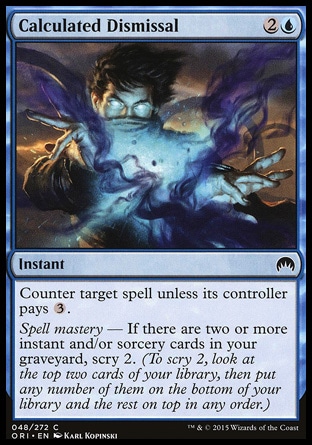
The effect of Spell Mastery on Calculated Dismissal creates an additional effect. When Calculated Dismissal resolves, if its target is legal, it will have its effect anyway, then the graveyard is checked for instants and sorceries, and if that condition is matched too, the scrying part occurs.
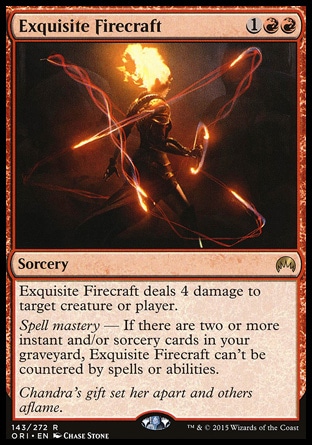
Exquisite Firecraft’s effect is very distinctive. It modifies the characteristics of the spell ability long before the spell resolves. As long as its controller has two or more instant and/or sorcery spells in his or her graveyard, Exquisite Firecraft cannot be countered.
To get the Spell Mastery effect, you need to have two or more instant and/or sorcery cards in your graveyard at the time it matters (usually during resolution). Obviously, the very spell with Spell Mastery won’t count, as it will still be on the stack when the game performs this check.
A split card is still one card, despite the fact that it has two halves with a spell on each. Having or not having Fuse is irrelevant too. A single Fire // Ice in your graveyard does not fill up your Spell Mastery.
If there are exactly two instant/sorcery cards in your graveyard, and you cast one with Spell Mastery using Flashback, it goes onto the stack. It will be there until the end of its resolution, so it will not be counted towards Spell Mastery.
The most important thing to keep in mind is that Spell Mastery effects that modify the way the spell resolves only become involved during the resolution of the spell they are on. As you are well aware by now, many things may happen between a spell being cast and resolving.
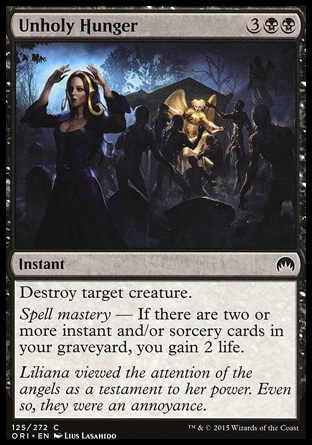
If all of a targeted spell’s targets become illegal, it is countered. None of its effects happen; the game isn’t concerned with its Spell Mastery part and doesn’t even check the player’s graveyard.
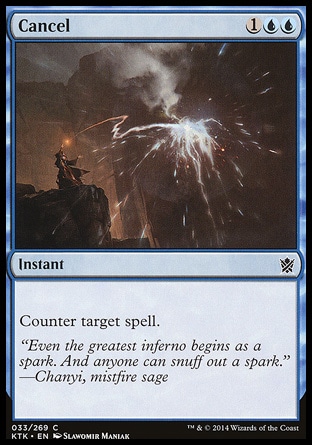
Same thing happens if the spell gets countered in another way. It doesn’t resolve, so the Spell Mastery part of Unholy Hunger has no effect.

The graveyard is checked on resolution to see if the Spell Mastery effect will apply. Your cunning opponent might mess with your graveyard so that at the time your Unholy Hunger resolves, you don’t get the extra effect.
A spell may resolve and have no effect. In that case we can still expect Spell Mastery to check our graveyard for that extra effect.
Unholy Hunger doesn’t take Predator Ooze out of the field, but is good enough to gain us 2 life, provided we can satisfy the Spell Mastery condition as the spell resolves.
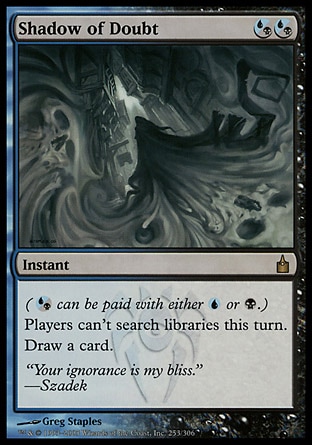
Shadow of Doubt shuts our Nissa’s Pilgrimage down. Even though we aren’t searching our library, believe it or not, our graveyard is checked for the instant and sorcery cards to determine which of the two effects we are not getting. Oh, but at least we do get to shuffle our library. Magic is a cruel game sometimes…
Spells with Spell Mastery may potentially become subject to the standard set of tricks of a true spellweaver.
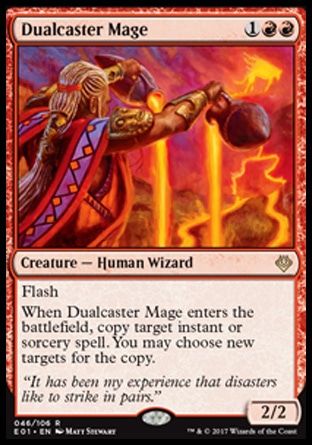
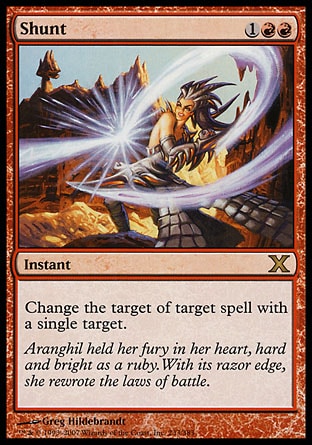
Our today’s center card, Nissa’s Pilgrimage allows searching our library for originally up to two basic Forest cards. The search instruction contains specific characteristics of the card, and besides, the wording “up to” allows us to find exactly zero basic Forests with pure conscience if we don’t need any for some reason.
If we do decide to find cards, the first one we find will be put onto the battlefield tapped. It is not played, so it doesn’t matter if you have already played a land in the current turn. It doesn’t even matter if this happens in your opponent’s turn — as long as you have found a way to cast Nissa’s Pilgrimage legally (Quicken).

We may find any land card with supertype Basic and subtype Forest per item of search. Snow-Covered Forest fits just fine, it matches all conditions.
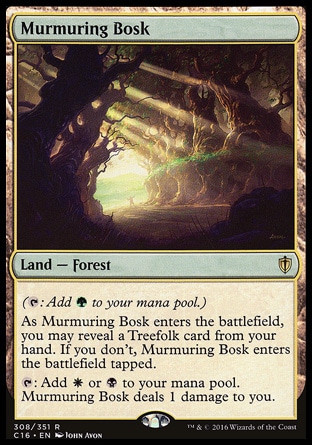
Despite the fact that Murmuring Bosk and Dryad Arbor are both Forests in a way, they may not be found with Nissa’s Pilgrimage. Neither is basic.
The second one we find will be revealed and put into our hand. If we had at least two instant and/or sorcery cards in our graveyard when Nissa’s Pilgrimage started resolving, we may find a third Forest, reveal it and put into our hand, too.
With the number of Magic cards with unique names inevitably nearing 15000, it is natural that we look back at past editions. Whether it is looking for identical or nearly identical cards, or comparing them with some that have ever existed, making such comparisons helps to better comprehend the power level of the new cards. This comparison is never official; however, most professional players recur to it, and they have set a number of terms which we shall get acquainted with.
Reprints
- Actual reprints — these are cards with the same name as those that have already been printed before. Some are eternal reprints that see life almost every year, such as Naturalize, some are much rarer and get reprinted very occasionally in Magic sets or in side-product, such as Urborg, Tomb of Yawgmoth.
- Functional reprints — these cards come out with a different name and flavor, but that covers all the differences between them. Each other part of the card — type, total cost, color, power/toughness (if any) are supposed to be the same. Remember how the cycle of Khans Dual lands mimicked the Refuge cycle from Zendikar?
Creatures aren’t rare within this type either. The most famous example would be the Fyndhorn Elves — Llanowar Elves — Elvish Mystic chain or reprints.
Functional reprints are very important for singleton formats, such as Commander (EDH). Imagine, for instance, that you play a mono-green Commander deck that can easily find 1-mana creatures. Fyndhorn Elves is a must in such a deck. Now, if all we had was just an actual reprint of Fyndhorn Elves, we’d only have that creature to use. Instead, we actually have up to three different ones — pack up as many as you feel you need. - Functional reprints safe for type — a good example is the card I used to compare our today’s center card with — Cultivate being a functional reprint of Kodama’s Reach. The latter is almost a copy of the former, except it has a spell type — Arcane.
These are in fact the most common reprints. You can imagine how many different creatures with different types there are that are, in fact, only different by their creature type. Devoted Hero — Volunteer Militia — Sanctuary Cat is by far not the biggest amalgamation of functional reprints safe for type. - Colorshifted (planeshifted) reprints — the last group within this type defines functional reprints with a different color. Subtypes are usually also disregarded to cover this group of reprints. The richest set on these was the Planar Chaos set of Time Spiral block, when many great cards saw planeshifted reprints. E.g.: Wrath of God — Damnation; Soul Warden — Essence Warden.
Strictly better/worse
This term describes the comparison of two cards, of which one is superior to the other in at least one aspect, while not being inferior in any aspect. These aspects may be total cost, power and/or toughness, instant speed, greater effect of the exact same nature in the rules text, or additional effects therein. Subtypes were also a deciding aspect some time ago, but later it became commonly disregarded, and for this reason Kodama’s Reach is no longer considered strictly better than Cultivate.
Complicated, isn’t it? Let us clear this up with a few simple examples:
- Lightning Bolt is strictly better than Shock because it has a greater effect and isn’t worse in any way.
- Lightning Bolt is strictly better than Shard Volley because it has a lower cost.
- Boil is strictly better than Boiling Seas because it may be played “at instant speed”;.
- War Priest of Thune is strictly better than Enlightened Ascetic because it has greater P/T values and isn’t worse in… Oh wait, it has different creature types, doesn’t it? Nobody cares!
Far from every similar pair of cards can be compared with each other. The classic example here is Dissipate vs. Dissolve. Which is better, scrying or exiling the countered card? There is a vast multitude of game states where either could be much more desirable, or totally useless, so these cards may not be compared to each other. However, both of them are strictly better than Cancel for obvious reasons.
One may argue that within a certain board state, a Shock would be far more desirable than Lightning Bolt, and of course, that is true. In fact, it’s not hard to picture such situation. But Magic is such a diverse game that you could picture such board states for virtually any pair of cards. For this reason, the board state is not taken into consideration when making card comparisons.
Finally, let’s see whether our today’s center card, Nissa’s Pilgrimage, can be compared in any of the above ways. It is obviously not a reprint, considering that Spell Mastery is a new ability keyword. The most curious for me was to compare this card with Kodama’s Reach and Cultivate. We do have a chance to find an additional land with certain condition; all these cards are sorceries that cost the same amount of mana. But Nissa’s Pilgrimage has one large downside compared to the two — it only searches for lands of one specific subtype. Its effect being better in one way and worse in another, we cannot say it is strictly better or worse than the pair.
What about Skyshroud Claim? This card is a sorcery, too, and searches for only two forests, and it even costs more! However, Skyshroud Claim puts both found Forests onto the battlefield untapped, and most importantly, those Forests do not have to be basic. Again, either isn’t strictly better than the other.
To me, that is great. The new card is not a power creep, or a reprint of a good old card already studied and played. It is a fresh touch to the game base that may prove useful over time across archetypes and formats. In fact, it is already played in some green Ramp Standard decks!
- ⇑ Tephraderm could be the card to make such a difference.
- ⇑ Power creep — slang term used to describe how newer content of a game outclasses the older, making older content obsolete and unwanted. According to Magic’s R&D, they are constantly fighting Power creep by balancing the power level between sets, juggling with different set mechanics and themes, etc.
- ⇑ Ramp — slang term for decks that use the first several turns to get additional sources of mana on top of just playing a land every turn, and then use the additional mana to play massive creatures and explosive spells. Owes its name to Rampant Growth. By the way, Nissa’s Pilgrimage is a new instrument in Ramp! =)


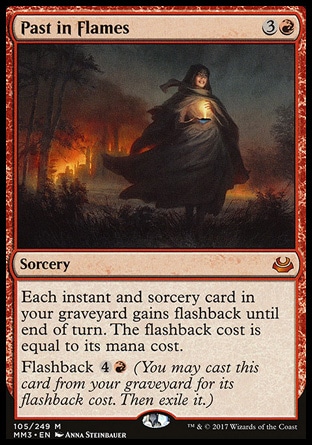
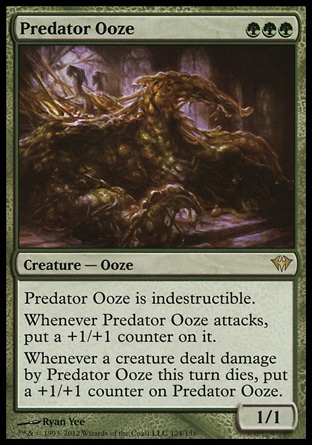
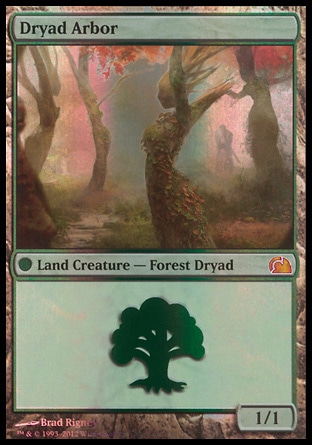
A spell may become copied; a targeted Spell Mastery spell may have its targets changed. In any case, the game will always check the graveyard of the spell’s controller for the number of instant and/or sorcery cards.